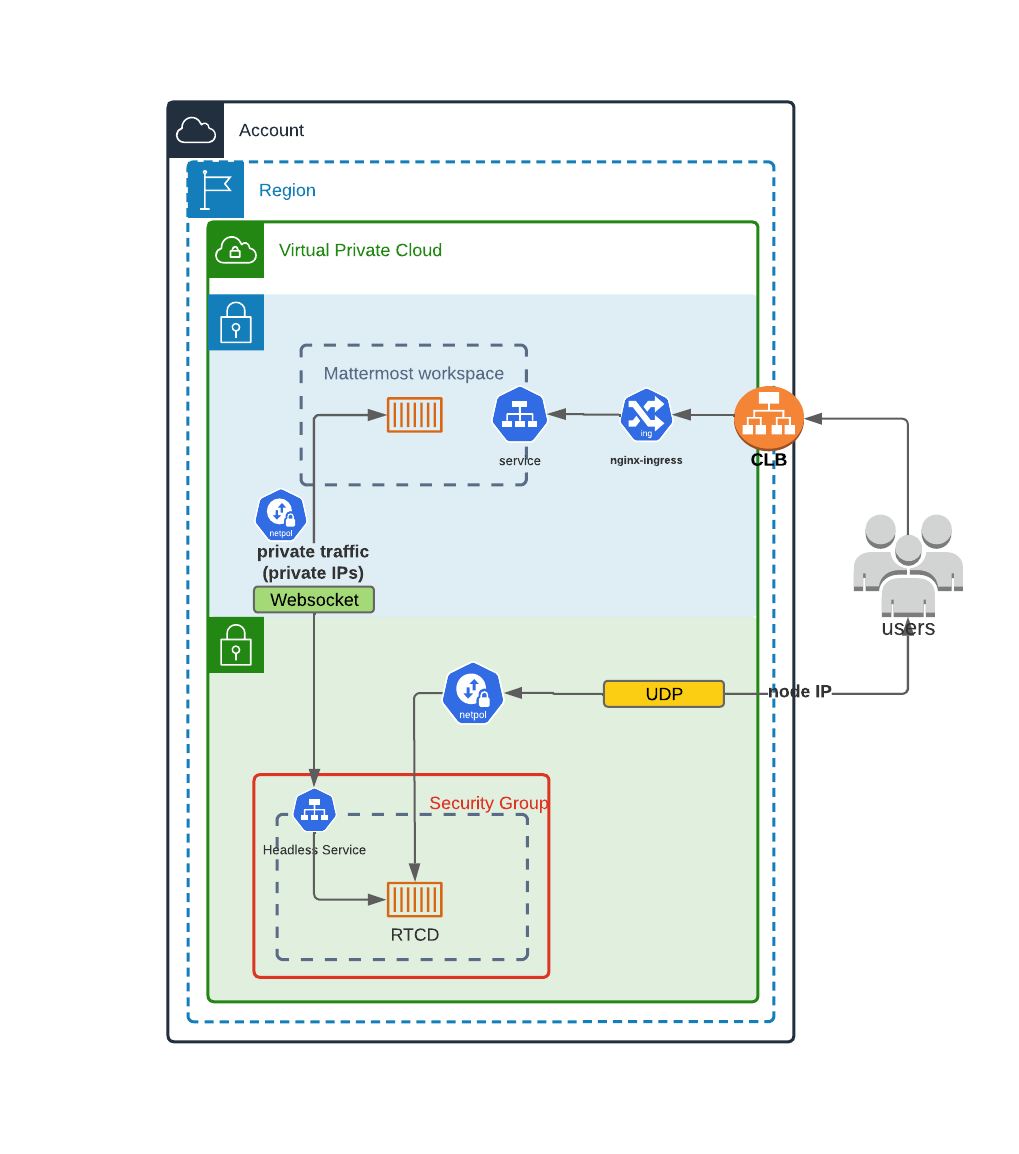Deploy Calls Kubernetes#
Available on all plans
Cloud and self-hosted deployments
This guide provides detailed information for deploying Mattermost Calls on Kubernetes environments.
Overview#
Mattermost Calls has been designed to integrate well with Kubernetes to offer improved scalability and control over the deployment. For Kubernetes deployments, the RTCD service is strongly recommended and is the only officially supported approach.
Architecture#

This diagram shows how the RTCD standalone service can be deployed in a Kubernetes cluster. In this architecture:
Calls traffic is handled by dedicated RTCD pods
RTCD services are exposed through load balancers
Scaling is managed through Kubernetes deployment configurations
Call recording and transcription is handled by the calls-offloader service (see Calls Offloader Setup and Configuration)
If Mattermost isn’t already deployed in your Kubernetes cluster and you want to use this deployment type, visit the Kubernetes operator guide.
Helm Chart Deployment#
The recommended way to deploy Calls-related components in a Kubernetes environment is to use the officially provided Helm charts:
RTCD Helm Chart#
The RTCD Helm chart deploys the RTCD service needed for call media handling:
helm repo add mattermost https://helm.mattermost.com
helm repo update
helm install mattermost-rtcd mattermost/mattermost-rtcd \
--set ingress.enabled=true \
--set ingress.host=rtcd.example.com \
--set service.annotations."service\\.beta\\.kubernetes\\.io/aws-load-balancer-backend-protocol"=udp \
--set rtcd.ice.hostOverride=rtcd.example.com
For complete configuration options, see the RTCD Helm chart documentation.
Calls-Offloader Helm Chart#
If you need call recording and transcription capabilities, deploy the calls-offloader service:
helm install mattermost-calls-offloader mattermost/mattermost-calls-offloader \
--set ingress.enabled=true \
--set ingress.host=calls-offloader.example.com
For complete configuration options, see the Calls-Offloader Helm chart documentation.
Kubernetes-Specific Configuration#
Network Configuration#
For Kubernetes deployments, you need to ensure specific connectivity paths:
Client to RTCD connectivity: UDP traffic on port 8443 is properly routed from clients to RTCD pods (for media)
Mattermost to RTCD API connectivity: TCP traffic on port 8045 must have a clear connectivity path from Mattermost pods to RTCD pods (for API communication)
Client to RTCD TCP fallback: TCP traffic on port 8443 can reach RTCD pods (for fallback connections when UDP fails)
Load balancer configuration: Load balancers must be properly configured to handle UDP traffic routing to RTCD pods
Network policies: Network policies must allow the required communications between Mattermost and RTCD services
Resource Requirements#
For optimal performance in Kubernetes environments:
CPU: At least 2 CPU cores per RTCD pod
Memory: At least 1GB RAM per RTCD pod
Network: Sufficient bandwidth for expected call volume (see benchmarks)
We recommend setting resource limits and requests in your deployment:
resources:
requests:
cpu: 1000m
memory: 1Gi
limits:
cpu: 2000m
memory: 2Gi
Scaling Considerations#
Horizontal scaling of RTCD pods is possible, but remember:
Each call is hosted entirely on a single RTCD pod
DNS-based load balancing should be used to distribute calls among pods
Health checks should ensure that only healthy pods receive new calls
Calls remain on their assigned pod for their entire duration
Limitations#
Due to the inherent complexities of hosting a WebRTC service, some limitations apply when deploying Calls in a Kubernetes environment.
One key requirement is that each rtcd process must live in a dedicated Kubernetes node. This is necessary to forward the data correctly while allowing for horizontal scaling. Data should generally not go through a standard ingress but directly to the pod running the rtcd process.
The general recommendation is to expose one external IP address per rtcd instance (Kubernetes node). This makes it simpler to scale as the application is able to detect its own external address (through STUN) and advertise it to clients to achieve connectivity with minimal configuration.
If, for some reason, exposing multiple IP addresses is not possible in your environment, port mapping (NAT) can be used. In this scenario different ports are used to map the respective rtcd nodes behind the single external IP. Example:
EXT_IP:8443 -> rtcdA:8443
EXT_IP:8444 -> rtcdB:8443
EXT_IP:8445 -> rtcdC:8443
This case requires a couple of extra configurations:
NAT mappings need to be in place for every
rtcdnode. This is usually done at the ingress point (e.g., ELB, NLB, etc).The
RTCD_RTC_ICEHOSTPORTOVERRIDEconfig should be used to pass a full mapping of node IPs and their respective port.Example:
RTCD_RTC_ICEHOSTPORTOVERRIDE=rtcdA_IP/8443,rtcdB_IP/8444,rtcdC_IP/8445
The
RTCD_RTC_ICEHOSTOVERRIDEshould be used to set the external IP address.
Note
One option to limit these static mappings is to reduce the size of the local subnet (e.g., to /29).
Monitoring and Metrics#
We recommend deploying Prometheus and Grafana alongside your Calls deployment:
Configure Prometheus to scrape metrics from both Mattermost and RTCD pods
Import the official Mattermost Calls dashboard to Grafana
Set up alerts for CPU usage, connection failures, and error rates
For detailed information on metrics collection and monitoring, see the Calls Metrics and Monitoring guide.
Troubleshooting#
For Kubernetes-specific troubleshooting:
Check pod logs:
kubectl logs -f deployment/mattermost-rtcdVerify service connectivity:
kubectl port-forward service/mattermost-rtcd 8045:8045Ensure UDP traffic is properly routed through your ingress/load balancer
Verify network policies allow required communication paths
For detailed troubleshooting steps, see the Calls Troubleshooting guide.
Other Calls Documentation#
Calls Overview: Overview of deployment options and architecture
RTCD Setup and Configuration: Comprehensive guide for setting up the dedicated RTCD service
Calls Offloader Setup and Configuration: Setup guide for call recording and transcription
Calls Metrics and Monitoring: Guide to monitoring Calls performance using metrics and observability
Calls Troubleshooting: Detailed troubleshooting steps and debugging techniques
If you encounter issues, see Calls Troubleshooting